What I Saw – by Jackie Philpott

Surfers And Doggies
I don’t know how many readers spend time down the coast in Monterey or Carmel, but I recommend it. It’s hard to beat the beauty and serenity of either city. One of my favorite walks is in Carmel, either on Carmel Beach or along the walking path above the city’s public beach. In mid-February of this year I visited the public beach.
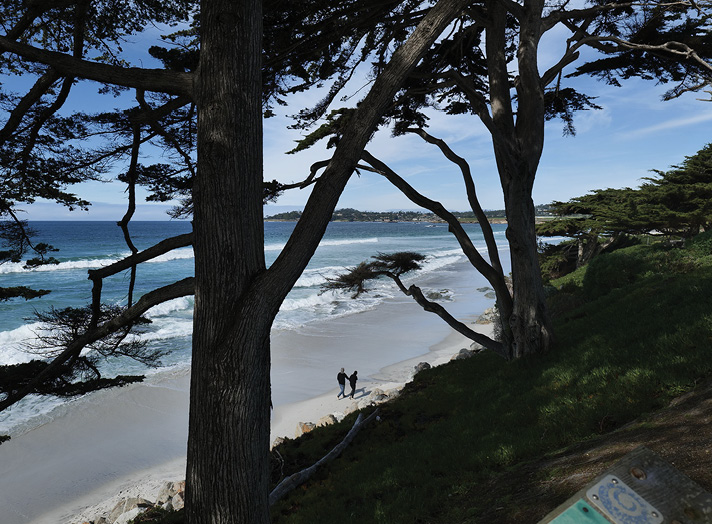
The town of Carmel is very dog-friendly and they run free all along the water’s edge. Big dogs, little dogs. I don’t have one myself, but still, it is fun to watch them get so excited playing with each other. This particular spot always has surfers too, more or less depending upon the conditions. They’re almost as fun to watch as the dogs. Earlier on this day, I watched as a surfer exited the water, scooped up his board and headed toward a sand path.
Catching up to Kelly Goldberg, I introduced myself and asked if he would mind talking with me for a minute or two. I indicated my camera, asked if I could interview him and take a photo of him with his surfboard. People take me more seriously if I have my camera around my neck.
Kelly smiled and said, “Sure.” I could tell he would be a good sport. Not everybody is.
He told me that he grew up in Carmel Valley and has been surfing at this beach his whole life; but the waves weren’t particularly good for surfing on this day, so he was heading for home. We talked about what makes for good conditions, and specifically at this location.
“When the swell comes from the northwest, that’s the best for this beach. When it comes from the south it goes right past this beach. It might come into this corner of the north end of the beach, but northwest wind is the best. You can’t beat this beach for beauty.”
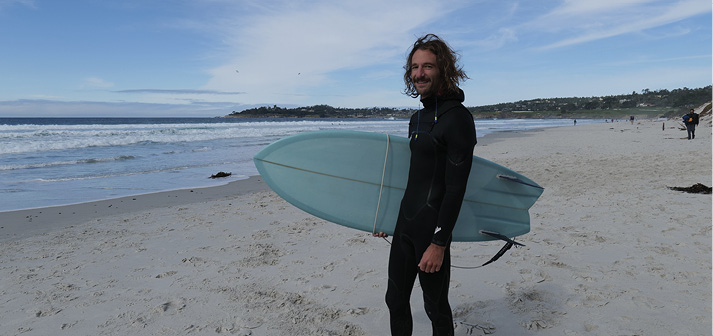
I asked why he surfs at this beach and not another one. He smiled and said, “I surf where my friends surf.”
When the conditions are fine, and all his friends are out on the water, there might be as many as 50 surfers spread out along the beach and in the water. He noted that recent weather conditions in early February had produced a really big swell.
We talked about the cost of housing in Carmel, which is significant. I asked him how he is able to stay in Carmel.
Kelly’s response was impressively thoughtful. He said, “I think that’s a really good question, especially for the younger people who grew up here and want to stay here. It’s almost impossible to make it happen. And it’s getting even harder. So, growing up here, I’m lucky because I have family and connections. I’ve been able to live here with cheaper rent than normal. And I’m getting an ADU built on my in-law’s property, so that’s how I’m able to make it work here really.
“I have a living wage but it’s still really difficult to buy real estate, to get in that game here. It’s ridiculous. I think, if you’re able to and it’s something you want to do, that’s the way to make it happen here. The trick is living with family for young people here.”
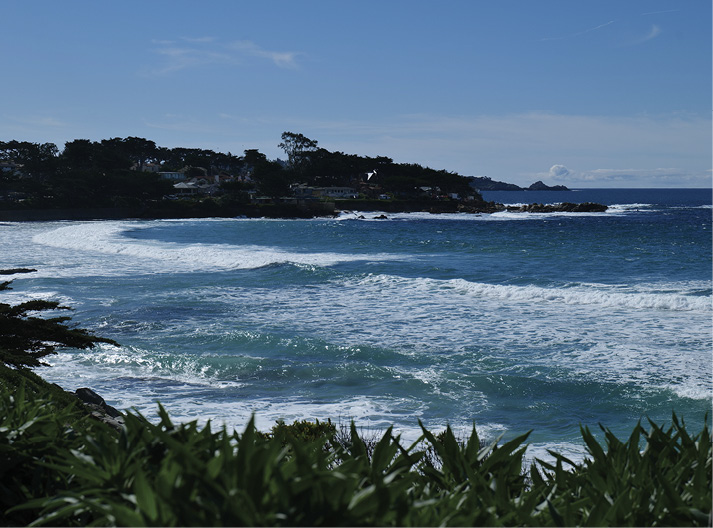
I shared my opinion, which is that staying nearby is probably good for his family, too, and that they might appreciate his presence.
When Kelly is not surfing, he is hiking and backpacking, often at Big Sur, which is about an hour down the coast. He is a psychologist with a master’s degree in counseling psychology. He’s also working toward a license for mental health counseling via an online program through the University of Massachusetts. Of the program he said, “I love it. It really worked out. I was able to do it online and be here. I didn’t want to go away to school again.”
Kelly works under a marriage and family therapist through a nearby non-profit called the Equine Healing Collaborative. It specializes in equine assisted psychotherapy.
He said, “I work with kids with autism and equine therapy is a really big deal for them.”
I’m familiar with equine therapy and we talk about it a bit longer. Then Kelly laughs, shakes his wet head like one of the dogs on the beach. I thank him and he carries his surfboard up the sand path to the road. I’m quite sure this surfer is very good at what he does in his other life.
The Second-Best Coconut Cream Pie In The USA
After saying goodbye to Kelly, I decide that I have worked hard and walked far enough to have earned dessert. Some people wait until 5 p.m. to have a drink. I never eat pie before noon. And it’s 12:45! So up the hill I slog to my favorite place in town, Patisserie Boissiere on Mission Street. It is a French restaurant with delicious food. This is where I always order my favorite dessert, coconut cream pie.
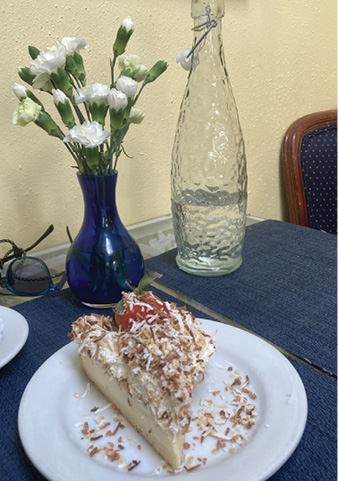
Wherever I go in the ENTIRE world, if there’s coconut cream pie on the menu? I order it. The best tasting pie I’ve ever had was in a tiny little feed store/deli in the Hill Country of Texas outside of San Antonio. But this pie comes in a very close second.
I try to get the owner to let me photograph him sitting at the table with his pie, but he demurs, says, “Oh, you don’t want to photograph this bird.” I suppose he was referring to his aquiline nose, or maybe the fact that he watches the tables like a hawk, making sure that customers never have to wait long for service, another demitasse of espresso, or in my case, a big fat slice of pie.
Korths Pirate’s Lair Marina To Emery Cove Yacht Harbor
This magazine focuses on power boats. Unfortunately, for some readers who have come to expect power boat stories, I know nothing about power boats. But I’m learning. A couple of years ago I went out on a lake on a power boat, and every summer Ty Mellott takes Bill Wells and me for a tour of the Delta on his yellow zoom zoom boat. That is always a lot of fun, for sure, but I remain woefully ignorant.
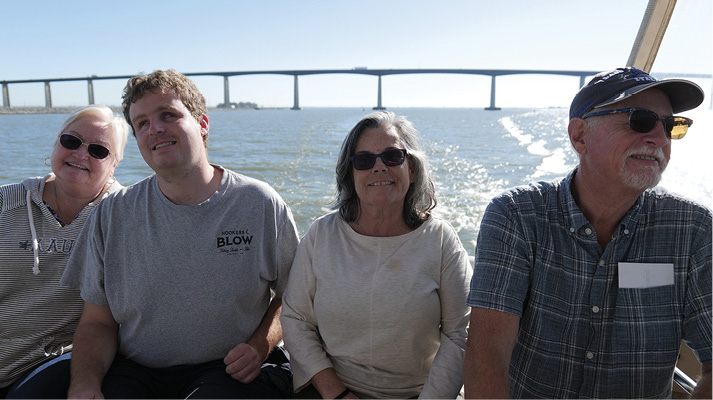
Lucky for me that a friend and colleague here at the Bay & Delta Yachtsman Magazine invited me along for a ride earlier this spring. Daniel Witte and his father, Dave, brought the family cabin cruiser down the river from Korth’s Pirate’s Lair Marina in Isleton to Emery Cove Yacht Harbor in Emeryville. Two family friends, Kathy Ventura and Leigh Oldenkamp were also aboard for the ride.
It was my first experience on a cabin cruiser and definitely my first ride on a flybridge. It seemed very luxurious. There were white vinyl seats upstairs and most of the electronics seemed to work. On sailboats, where cockpit electronics are exposed to salt water, this is often not the case. So, on this day I recalled the phrase “how the other half lives.” It is very different from sitting on an orange throw cushion in the cockpit of my own boat with a tablet chart plotter on my lap. Not that I’m complaining, but I did notice the difference.
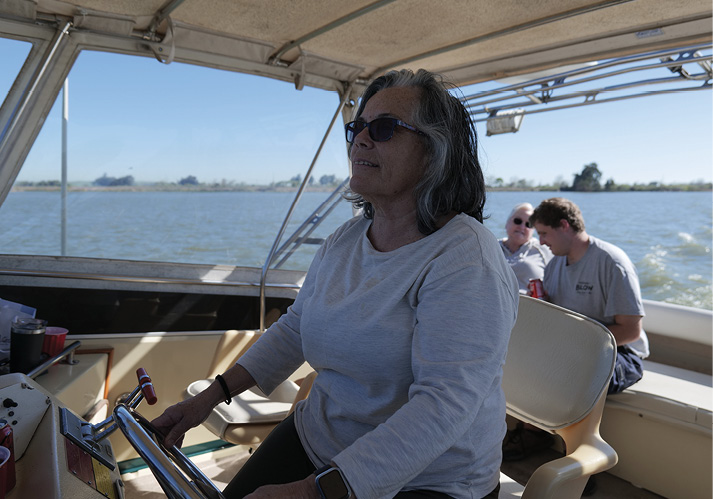
What did I learn from this trip down river on a 1985 39-foot Sea Ray Sportfisher, named Integrity? Well, the galley is generous, especially compared with DM’s tiny corner galley. There were two separate staterooms, one with a big bed, the other with bunk beds. Since my own stateroom is a mere v-berth full of sailbags, a deflated rubber dinghy and aluminum oars, it seemed remarkably civilized by comparison. There was a saloon with big comfy chairs, and a cockpit. I referred to it as a back porch but was gently corrected. And then there was that flybridge. First the Delta, then the Suisun and San Pablo Bays passed beneath us. Everything was very comfortable indeed.
Daniel and I meet for lunch periodically, and he uses a collapsible cane to feel his way forward when we walk together. How does he steer a 39-foot power boat? Well, since there aren’t currently chart plotters that are voice activated, Daniel steers with a bit of help. His father stands next to him and unobtrusively touches his left or right shoulder. They have some sort of unspoken agreement, which seems to suggest a two degree turn per tap. All the while the two fellas kept up the conversation, while we crew members lounged around like cats.
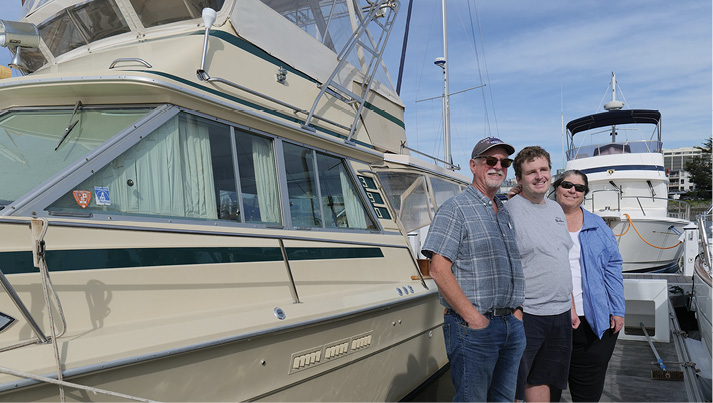
Seeing the Delta from up high instead of down low on a sailboat was significantly different, too, and Dave pointed out all the marinas along the way. We went past the “used to be” Driftqwood Yacht Club to port in Oakley, just before we motored under the Antioch Bridge. Checking it out online I see that the WTF Restaurant Bar & Grill is located there. Of course, everyone knows that WTF is an acronym for Whiskey Tango Foxtrot, and its website makes it look very appealing. Then there is that tagline: Serving those who Serve. When I head for the Delta this summer I will call ahead, see if my sailboat with her 4.5-foot draft can get in there. Dave equivocated, said, “Sure! Well… maybe.”
We passed the Antioch Powerplant, which has been decommissioned for years now. A lively conversation ensued about how it might be redeveloped for affordable condominiums. We agreed that probably won’t happen, but stranger things are happening in Rio Vista, so who knows?
At the end of the afternoon we finally docked at Emery Cove Yacht Harbor which will be Integrity’s new home. Daniel will edit this column from the comfort of his new man cave a couple of days a week. Emery Cove is a beautifully maintained marina and I wish him well there. Need I mention that it is only steps from Trader Vic’s tiki bar?
Big Daddy Regatta
There are a number of big sailing regattas on the SF Bay. One is the Big Daddy, organized by the Richmond Yacht Club and named after a former commodore, Bob Klein. You may have seen the yellow buoy named after him, just north of the decrepit remains of the Southampton Shoal mark. Best to stay clear of what remains of the shoal mark, by the way. Bits of it are gradually breaking apart and besides, it smells bad.
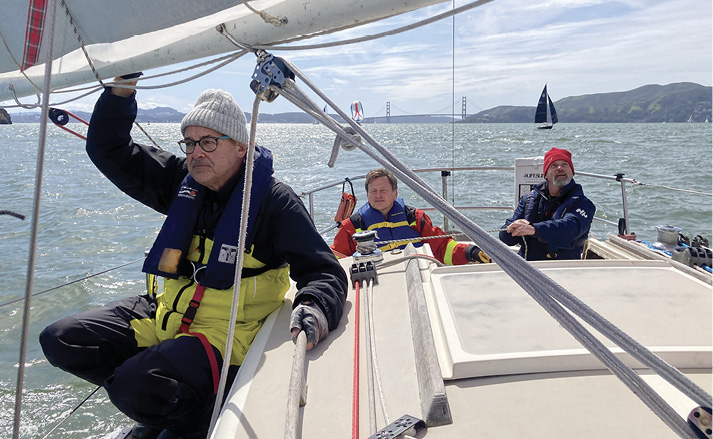
Big Daddy is a two-day race. Saturday offers a series of buoy races on three separate courses. On March 10, 79 boats were registered to race. Big boats, little boats and everything in between. After the race on Saturday there was a big party at the clubhouse with dinner, drinks at the bar and dancing to a live band if you were so inclined. And people who do this race? They are so inclined. That party is the stuff of sailing movies.
Sunday morning sailors who have recovered from the night before are offered a pursuit race. This year’s pursuit race had 115 boats registered. At the end of the day Fred Paxton, the pro for the event, announced that there had been enough wind for every boat to finish. So early in the season that is a rare and fortuitous event. The course starts on the Richmond Riviera and winds around Angel Island and Alcatraz in any direction. A pursuit race means that your boat’s rating determines your start, with slow boats starting first and faster ones afterward. Get it?
I’ve sailed on other people’s boats in the Big Daddy before, but this was the first time I registered my own boat. Most of the other boats in the Big Daddy Regatta are full of people. I decided that this would be the year to throw caution to the wind, invite friends along. Why not? It had to happen sooner or later. So, I did and three other singlehanders joined me. Four people accustomed to sailing their own boats solo. What could possibly go wrong?
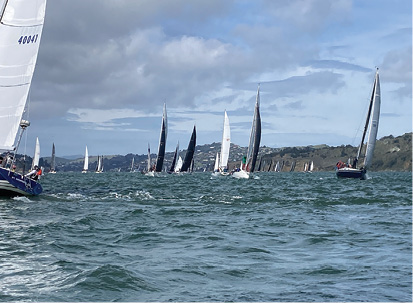
Sunday morning offered an unexpected and much appreciated little breeze, which meant that boats without engines – like mine – were able to easily sail out of their slips and arrive on time to the start, just southwest of Potrero Reach.
I had invited three really good sailors to be crew du jour. Greg Ashby and Jim Quanci have both completed the Singlehanded Transpacific race to Kauai and Jan Hirsch grew up sailing in Germany. Let’s just say that they know their way around a mast.
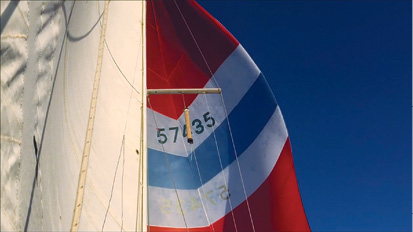
Anyone who has ever sailed in the Fiasco knows about the concept of hindsight. For sailors this is generally only used in the context of regret. Big Daddy participants suffer from similar emotions, with the added emotion known by its acronym WWIT! (What Was I Thinking!).
Before our start we discussed the best way to go: Should we enter Raccoon Strait first, and circle Alcatraz to port? Or sail straight toward the city front, catch the wind sooner? I’ll be honest. If I had been alone on my boat, I would have gone counterclockwise, sailed wing on wing on the downwind leg. Instead, because we were all used to being captain and commander of our own boats, we politely declined to make any decisions at all. Instead, we behaved in a civil manner, as if we were officers of a non-profit agency. In other words, we sailed by consensus.
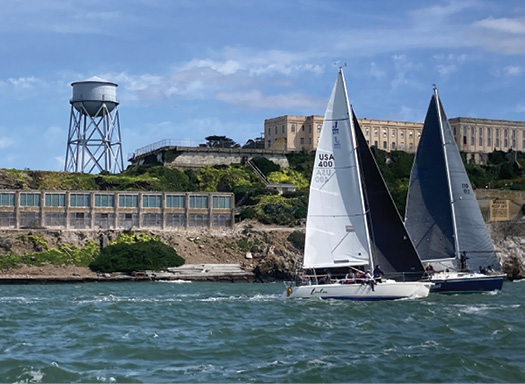
What does that look like on a slow boat with a long tiller steered by four people in a small cockpit? Well, it was a tight squeeze and we laughed a lot as we jockeyed for room. After starting the race in very little wind, we agreed to circle Alcatraz and Angel Island clockwise. At the start of the race that central Bay looked so much more inviting than Raccoon Strait. By the time we came around the corner of Alcatraz the wind had kicked up and what was this? More than half the fleet was heading straight toward us! AND THEY WERE ALL ON STARBOARD!!! Every one of them had right of way.
My crew didn’t flinch. We knew what we were doing! We threaded our way through all those boats. Once in a while we wandered up and down to the rail. We were still having a good time. We were laughing. But then a fateful decision was made: We raised my biggest spinnaker.
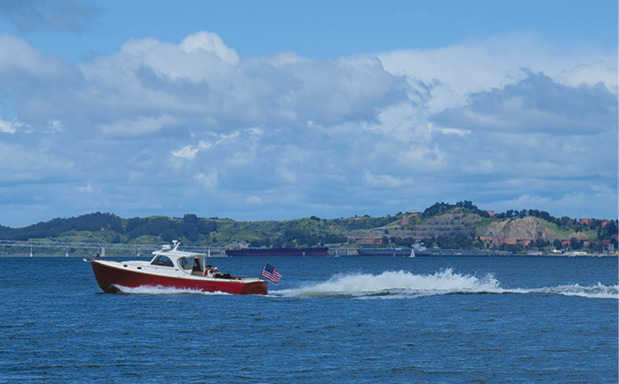
The fella at the bow called “made!” and a hush fell over the vessel as the spinnaker rose before us.
My spinnaker, it is red white and blue, with multiple bits of colored sail tape where rips have been patched together. There is blue tape on red nylon and red tape on white nylon. There are some pinholes. I admit that it has seen better days.
“Do they even make spinnakers that way anymore?” asked one member of my crew.
“How old is that sail?” asked another.
“I’ll bet that sail is 20 years old,” someone else speculated.
My response?
“That spinnaker was 20 years old when I bought it in 2012.”
They all shook their heads and laughed, realizing that we would lose time – a lot of time – because of that spinnaker. To be fair, it is also true that we had a lot of competition.
Here is what fast racing boats look like sailing against the backdrop of Alcatraz Island. They were so fast I had a hard time focusing the camera.
If I had done the Big Daddy solo, I might have won first overall. Or maybe not. Regardless, I’d like to thank my crew for coming along. I had a splendid time. I hope they weren’t too embarrassed to finish at #90.
Preparing For Offshore Sailing
Sometimes, as I’ve written before, you need a little help with your boat. A friend needed help with the swim platform on his catamaran. Would I be interested in helping? Well, of course I would!
Cliff Shaw has a 32-foot catamaran, the S/V Rainbow. Last year he returned from the South Pacific. He told me that Rainbow’s swim platform is a raw foam/epoxy/carbon fiber panel fabricated for him by Greg Nelsen, owner of the Oakland company Hi-Modulus. Before he left San Francisco Rainbow’s platform had been bolted to the back of the boat. While returning across the Pacific the waves had slammed up from below and shaken loose the screws that held the swim ladder on to the transom.
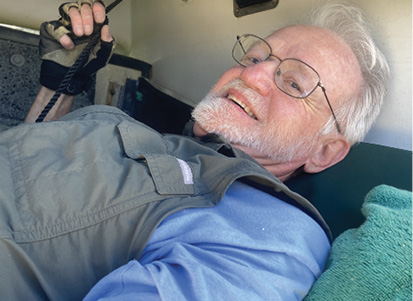
What to do? Cliff considered the traditional lashings used by the ancient Polynesian mariners for their own catamarans. Not having metal for screws and bolts, they created ropes from the fiber of coconut fiber, which is very strong. He told me, “I looked at how the Polynesians lashed bits to their catamarans, using natural ingredients from trees and plant roots.”
On a very nice Sunday in March I went over to Emery Cove Yacht Harbor and helped Cliff finish lashing his new platform onto his multihull. First, I floated underneath the platform on his shallow dinghy and fed rope up through holes along the edge of the panel. I thought we were done. But no! There were 146 holes left to thread!
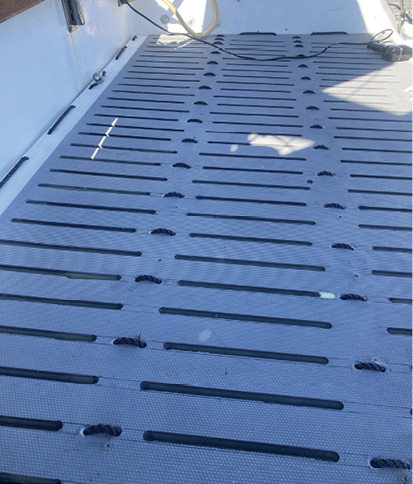
Then it was Cliff’s turn to float underneath the platform. One hundred and forty-six times I pulled rope up and threaded it down to Cliff, where he pulled the lashing tight against the bottom of the panel. It was hard work for Cliff, whereas I just sat in the sunshine and waved to boaters as they motored slowly past on their way to the channel entrance. Sometimes do it yourselfers need just a little help from friends. It was my pleasure to do so.
Coconut sennit cordage is still being made in many places in the Pacific. Both the green and dry husks of the coconut are used. Not having enough coconut sennit at hand, Cliff instead used black polyethylene rope. It is mildew & mold resistant, won’t ever rot and dries quickly. It is used by lobster fishermen for their floating lobster traps. You would recognize it: It’s that floating rope that wraps around your prop when you go offshore. Best to watch carefully. The pots are usually tied together in rows, so you can expect to see that rope floating in between, just waiting for you and your unsuspecting boat.
Next Month
Next month I plan to visit Lowell and Apo Harrison. Lowell has had a diving business for years and spends a good amount of time underwater, cleaning the bottoms of my dock neighbors’ boats in Richmond. Lowell and Apo have opened a new canvas shop, Berkeley Marine Canvas, located in the Berkeley Marine Center. Here is a photo of Lowell imitating a seal.
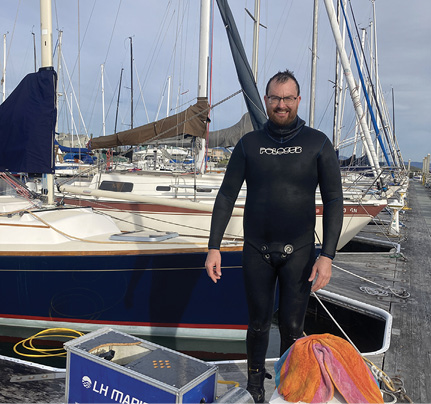
On April 6 the 70th annual Bullship Run of the El Toros will occur between Sausalito and the City Front. It’s sorta kinda like the Running of the Bulls in Pamplona, Spain, but with no bullfight at the end. Instead, I think we’ll have lunch at the St. Francis. Oh, gosh. The sacrifices I make to provide stories for your reading pleasure.
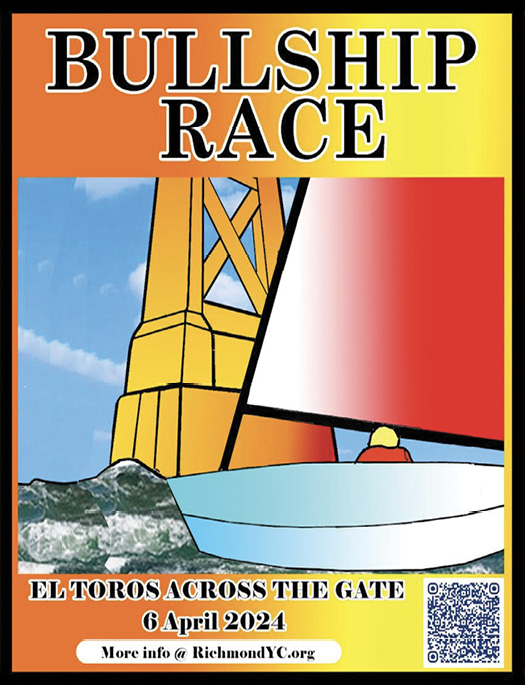
Corrections
In April’s column the Treasure Island restaurant, co-owned by MeeSun Boice and Parke Ulrich, was misspelled. It is MERSEA, not Mersee.
Also, the wall to ceiling tank in the bar of their new restaurant Hurrica at the Westpoint Harbor is full of baby jellyfish, not octopi. Apologies.
In the meantime, enjoy your time on the water and please write to tell me about your own boating experiences. I can be reached at jackie@yachtsmanmagazine.com. Thank you for reading, and let’s all be careful out there.



